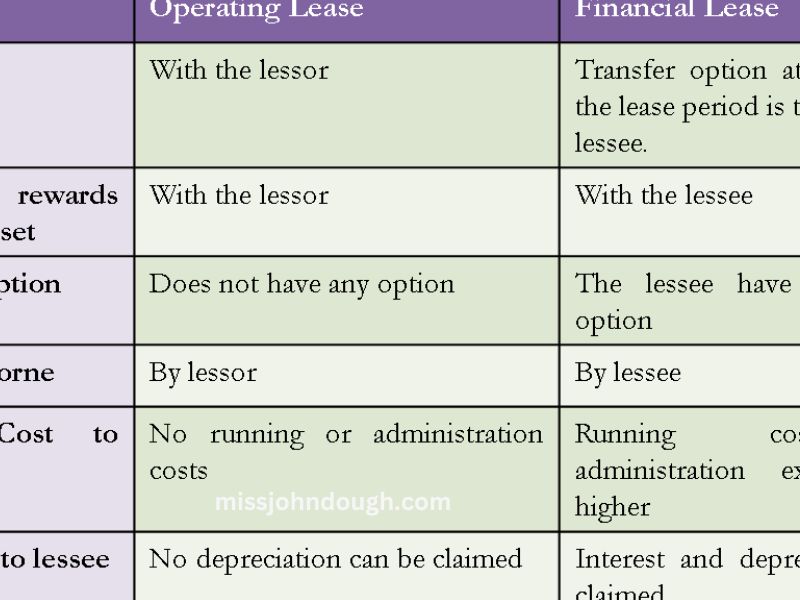When it comes to acquiring assets, businesses and individuals often find themselves choosing between two primary options: financing and leasing. Both methods have distinct characteristics, benefits, and considerations that can impact financial outcomes. In this article, we will explore the differences between finance and lease, with a focus on how each option works, the benefits they provide, and how to determine which option is right for your specific needs.
What is Financing?
Finance refers to the process of borrowing money to purchase an asset. This method is commonly used by businesses and individuals who want to eventually own the asset. Financing usually involves a loan agreement with a lender, where the borrower is required to repay the loan amount, often with interest, over a set period. At the end of the loan term, the borrower owns the asset outright.
Key Features of Financing
- Ownership: With financing, the borrower has the intention of owning the asset after the loan is fully paid off. This means that, unlike leasing, the borrower will eventually have full control over the asset.
- Equity Building: As payments are made, equity in the asset builds, which can be leveraged in the future.
- Interest Charges: Financing typically involves interest charges, making it more expensive in the long term than leasing. The total cost will depend on the interest rate, loan duration, and the value of the asset being financed.
- Flexibility: Once the loan is paid off, the borrower has the option to keep, sell, or trade the asset. There are no restrictions on the use of the asset after ownership is transferred.
Advantages of Financing
- Asset Ownership: The key benefit of financing is that the borrower will eventually own the asset, providing long-term value and flexibility.
- Customization: Once owned, the asset can be modified, sold, or used as collateral for other loans.
- Tax Benefits: Depending on the jurisdiction, there may be tax incentives for asset ownership, such as depreciation deductions for business purposes.
Disadvantages of Financing
- Higher Costs: Financing can be more expensive due to interest rates, down payments, and fees associated with the loan.
- Longer Commitment: Financing typically involves longer repayment terms, which may result in larger monthly payments.
- Depreciation: For certain types of assets, such as vehicles and equipment, the value of the asset may depreciate over time, resulting in a loss of value even though the borrower still owes a balance.
What is Leasing?
A lease is a financial agreement where the borrower (lessee) pays a series of payments to the owner (lessor) in exchange for the right to use an asset for a specific period. Unlike financing, leasing does not involve ownership at the end of the lease term. Instead, the lessee returns the asset to the lessor or has the option to renew the lease.
Key Features of Leasing
- No Ownership: Leasing is typically used for short-term access to an asset without the intention of ownership. The lessee does not build equity in the asset.
- Monthly Payments: Similar to financing, leasing involves monthly payments; however, these payments are generally lower than those for financed assets because the lessee is only paying for the asset’s depreciation during the lease term.
- Maintenance and Service: In many cases, leases include maintenance services, ensuring the asset remains in optimal condition. This can be particularly advantageous for business equipment or vehicles that require regular servicing.
- End of Lease Options: At the end of the lease term, the lessee may have the option to purchase the asset, return it, or enter into a new lease agreement.
Advantages of Leasing
- Lower Payments: Since the lessee does not own the asset, the monthly lease payments are often lower than financing payments. This can make leasing an attractive option for those with limited cash flow.
- Access to Newer Assets: Leasing allows individuals or businesses to regularly upgrade to newer models or versions of assets, such as cars or equipment, without being burdened with outdated technology or assets.
- Lower Upfront Costs: Leasing typically requires little to no down payment, making it a more accessible option for businesses or individuals who do not have the capital to make a large purchase.
- Tax Deductions: Lease payments may be deductible as business expenses for tax purposes, providing additional financial benefits.
Disadvantages of Leasing
- No Ownership: The biggest drawback of leasing is that the lessee does not own the asset at the end of the lease term, which means that they cannot build equity in the asset.
- Long-Term Cost: While monthly lease payments may be lower, over an extended period, the total cost of leasing may exceed the cost of purchasing the asset outright.
- Limitations on Use: Lease agreements often come with restrictions on how the asset can be used. For example, mileage limits on leased cars or restrictions on modifications to leased equipment.
Key Differences Between Finance and Lease
While both finance and lease offer distinct advantages, there are several key differences that should be considered when choosing between the two options.
1. Ownership and Equity
- Finance: At the end of a financing agreement, the borrower owns the asset and can leverage it as they see fit.
- Lease: The lessee never owns the asset, and once the lease term ends, they must return it to the lessor unless a purchase option exists.
2. Monthly Payments
- Finance: Monthly payments for financed assets are generally higher than lease payments because the borrower is paying off the entire value of the asset, plus interest.
- Lease: Lease payments are typically lower because the lessee is only paying for the asset’s depreciation during the lease term.
3. Tax Implications
- Finance: Ownership of the asset may allow for tax deductions related to depreciation or interest payments, depending on the jurisdiction.
- Lease: Lease payments may be fully deductible as a business expense, offering tax benefits for those using the leased asset for business purposes.
4. Flexibility and Maintenance
- Finance: The borrower has full control over the asset once it is paid off, but is responsible for its maintenance and upkeep.
- Lease: Leases often include maintenance services, and the lessee can choose to upgrade or return the asset at the end of the lease term.
5. Upgrades and New Technology
- Finance: With financing, the borrower is locked into the asset until it is paid off. Upgrading to a newer model or version of the asset may require selling or trading the old one.
- Lease: Leasing allows for easier upgrades to newer models or versions of the asset, as the lease agreement can be renewed or a new lease can be signed at the end of the term.
6. Long-Term Cost
- Finance: In the long term, financing may be more cost-effective if the asset is used for many years after it is paid off.
- Lease: Leasing may result in higher long-term costs if the lessee continually renews the lease or leases new assets without ever owning them.
When to Choose Financing
Financing is the ideal option when:
- You want to eventually own the asset and have full control over it.
- You plan to use the asset for an extended period, which may make ownership more cost-effective in the long run.
- You need to build equity or use the asset as collateral for other financial needs.
When to Choose Leasing
Leasing is the better option when:
- You want lower monthly payments and minimal upfront costs.
- You prefer using the latest technology or equipment without committing to ownership.
- You need flexibility, such as the ability to upgrade or return the asset at the end of the lease term.
- You need maintenance and service included as part of the deal.
Conclusion
The decision between financing and leasing depends on your financial goals, the type of asset you’re acquiring, and your long-term plans. Financing allows for ownership and the opportunity to build equity, but it typically comes with higher payments and long-term commitments. Leasing, on the other hand, offers lower upfront costs and flexibility, but without ownership of the asset. By understanding the key differences between finance and lease, you can make an informed decision that aligns with your financial strategy and asset needs.
Whether you’re a business looking to acquire equipment or an individual contemplating the purchase of a vehicle, carefully evaluate your options to choose the method that best fits your budget, financial goals, and future plans.


